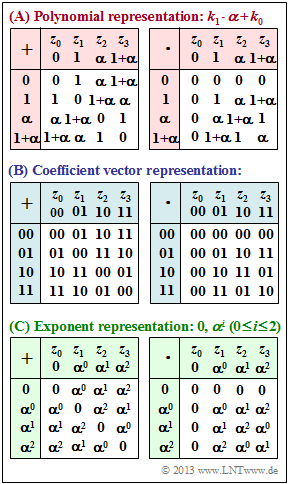Exercise 2.4: GF(2 to the Power of 2) Representation Forms
From LNTwww
Opposite you can see the addition table as well as the multiplication table for the extension field $\rm GF(2^2)$ in three different variants:
- the polynomial representation,
- the coefficient vector representation,
- the exponent representation.
Hints:
- The exercise refers to the chapter "Extension fields".
- All necessary information about ${\rm GF}(2^2)$ can be found on the "first page" of this chapter.
- In subtask (4) the following expressions are considered:
- $$A = z_2 \cdot z_2 + z_2 \cdot z_3 + z_3 \cdot z_3,$$
- $$B = (z_0 + z_1 + z_2) \cdot (z_0 + z_1 + z_3).$$
Questions
Solution
(1) The proposed solutions 1, 2 and 5 are applicable. Justification:
- If $\alpha = 0$ or $\alpha = 1$, the pseudo element $\alpha$ would be indistinguishable from the other two ${\rm GF}(2)$ elements $0$ and $1$.
- The modulo-2 calculation can be recognized from the addition table. For example, $1 + 1 = 0, \ \alpha + \alpha = 0, \ (1 + \alpha) + (1 + \alpha) = 0$, etc.
- From the multiplication table we see that $\alpha^2 = \alpha \cdot \alpha = 1 + \alpha$ holds $($3rd row, 3rd column$)$. Thus also
- $$\alpha^2 + \alpha + 1 = 0.$$
(2) Correct is the solution suggestion 2. Thus
- "$01$" for the element "$1$" and
- "$10$" for the element "$\alpha$".
(3) Correct are the solutions 2 and 3:
- It is true that $\alpha^0 = 1$ and $\alpha^1 = \alpha$.
- For the underlying polynomial $p(x) = x^2 + x + 1$, it further follows from $p(\alpha) = 0$:
- $$\alpha^2 +\alpha + 1 = 0 \hspace{0.3cm} \Rightarrow\hspace{0.3cm} \alpha^2 =\alpha + 1 \hspace{0.05cm}.$$
(4) According to the tables of polynomial representation holds:
- $$A \hspace{-0.15cm} \ = \ \hspace{-0.15cm} z_2 \cdot z_2 + z_2 \cdot z_3 + z_3 \cdot z_3 = \alpha \cdot \alpha + \alpha \cdot (1+\alpha) + (1+\alpha) \cdot (1+\alpha) = (1+\alpha) + (1) + (\alpha) = 0 = z_0 \hspace{0.05cm},$$
- $$ B \hspace{-0.15cm} \ = \ \hspace{-0.15cm} (z_0 + z_1 + z_2) \cdot (z_0 + z_1 + z_3) = (0 + 1 + \alpha) \cdot (0 + 1 + 1+ \alpha) = (1+\alpha) \cdot \alpha = 1 = z_1 \hspace{0.05cm}.$$
- Therefore, the proposed solutions 1 and 2 are correct.
- The same results are obtained with the coefficient vector representation:
- $$A \hspace{-0.15cm} \ = \ \hspace{-0.15cm} z_2 \cdot z_2 + z_2 \cdot z_3 + z_3 \cdot z_3 = (10) \cdot (10) + (10) \cdot (11) + (11) \cdot (11) = (11) + (01) + (10) = (00) = 0 = z_0 \hspace{0.05cm},$$
- $$B \hspace{-0.15cm} \ = \ \hspace{-0.15cm} (z_0 + z_1 + z_2) \cdot (z_0 + z_1 + z_3) = [(00) + (01) + (10)] \cdot [(00) + (01) + (11)] =(11) \cdot (10) = (01) = z_1 \hspace{0.05cm}.$$
- And finally with the exponent representation:
- $$A \hspace{-0.15cm} \ = \ \hspace{-0.15cm} z_2 \cdot z_2 + z_2 \cdot z_3 + z_3 \cdot z_3 = \alpha^1 \cdot \alpha^1 + \alpha^1 \cdot \alpha^2 + \alpha^2 \cdot \alpha^2 = \alpha^2 + \alpha^3 + \alpha^4 = \alpha^2 + \alpha^0 + \alpha^1 = 0 = z_0 \hspace{0.05cm},$$
- $$B \hspace{-0.15cm} \ = \ \hspace{-0.15cm}(z_0 + z_1 + z_2) \cdot (z_0 + z_1 + z_3) = [0 + \alpha^0 + \alpha^1] \cdot [0 + \alpha^0 + \alpha^2] = \alpha^2 \cdot \alpha^1 = \alpha^3 = \alpha^0 = z_1 \hspace{0.05cm}.$$
